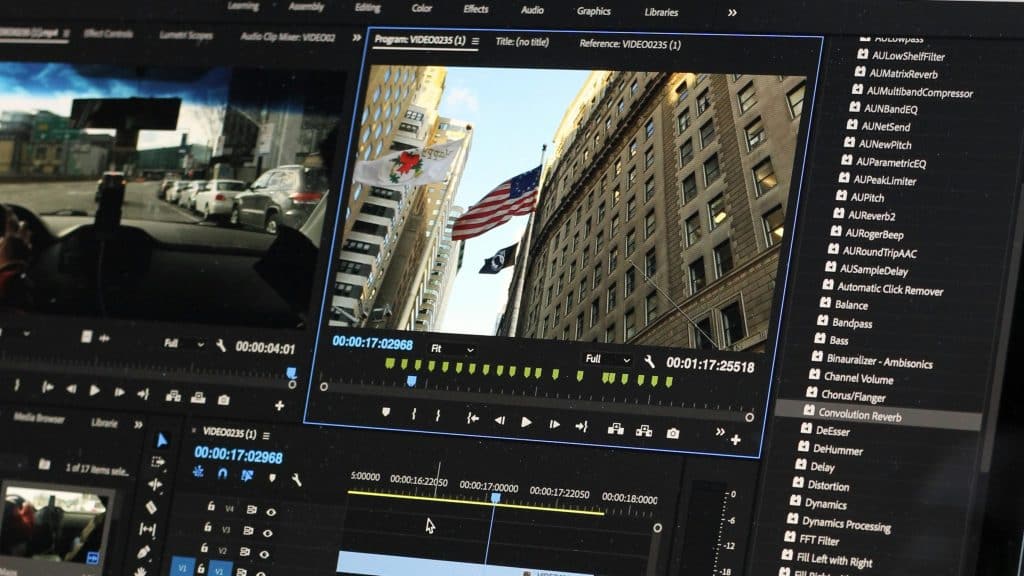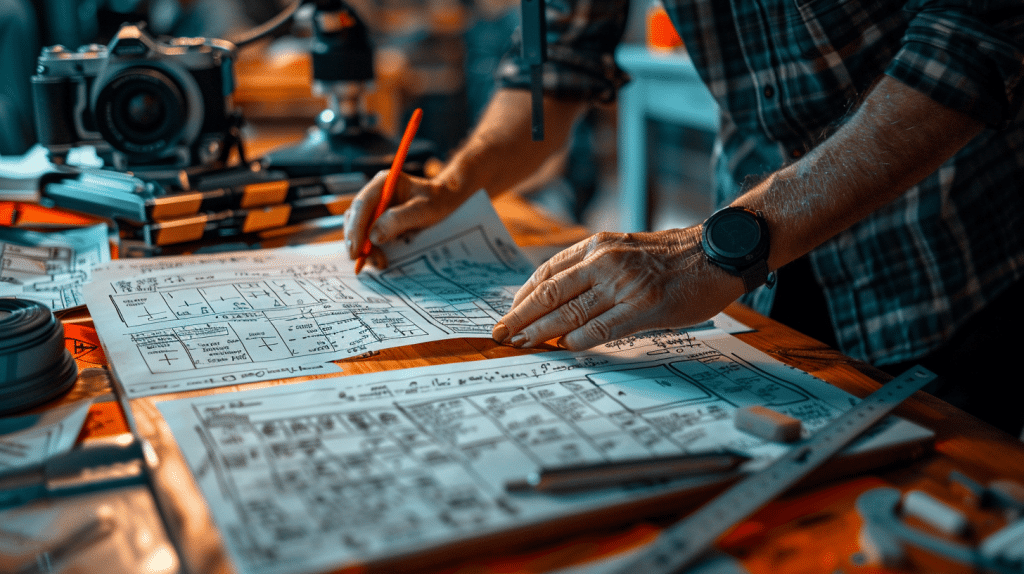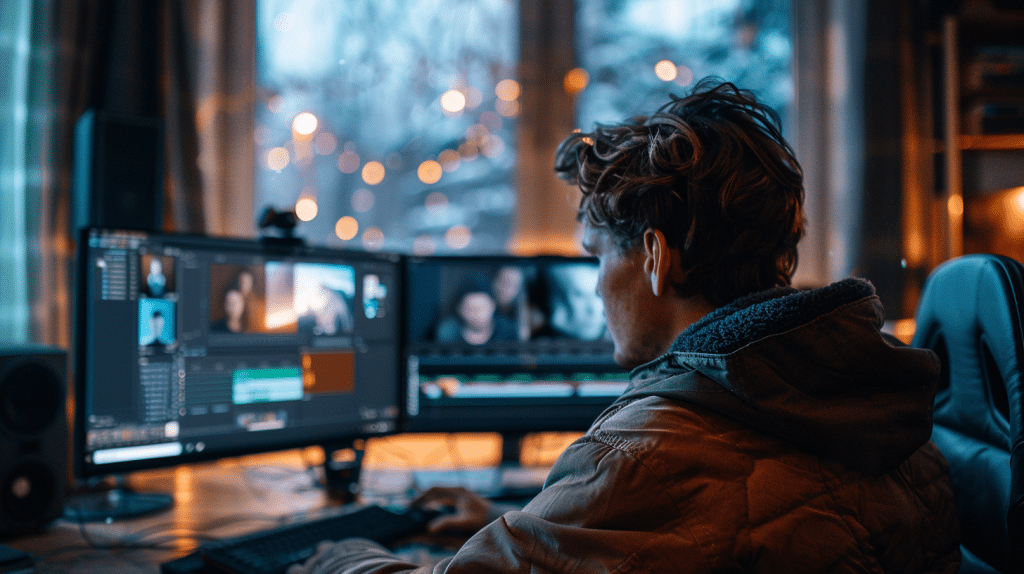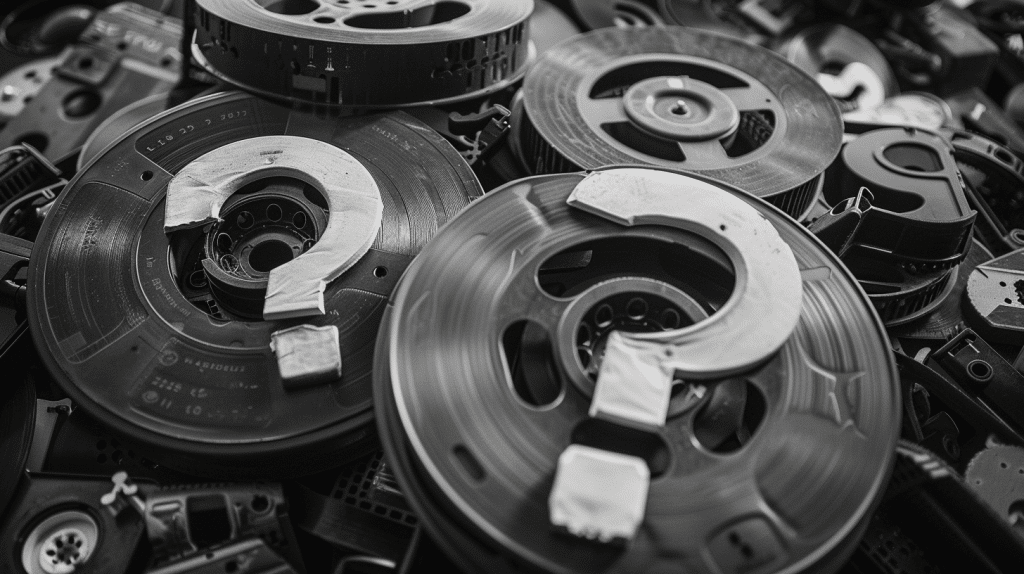The Power of Continuity Editing: Maintaining Coherence and Flow in Your Story

When you’re crafting a visual story, continuity editing becomes your best ally in maintaining coherence and flow.
It involves more than just connecting scenes; it’s about ensuring every detail, from props to actors’ positions, aligns perfectly to keep the audience immersed.
Without this meticulous attention, even minor discrepancies can pull viewers out of the narrative. But how exactly do you achieve such seamless progressions?
By exploring various tools and techniques, you’ll discover how to uphold the illusion of continuous time and space, guiding your audience effortlessly through your story.
Table of Contents
Definition of Continuity Editing
Continuity editing, at its core, is a film editing technique that guarantees a seamless and logical flow from one shot to the next, maintaining the illusion of continuous time and space for the viewer.
When you’re delving into the world of editing fundamentals, understanding continuity editing is essential. It’s all about creating a coherent visual storytelling experience that keeps the audience engaged and immersed in the narrative.
You’ll find that continuity editing involves a series of specific techniques designed to make the shift between shots as smooth and invisible as possible.
This means paying meticulous attention to details like matching action, eyeline, and screen direction. Each cut should feel natural, guiding the viewer effortlessly through the story without drawing attention to the editing itself.
Importance of Seamless Transitions
Smooth changes are essential because they guarantee that each shift feels natural, keeping your audience fully immersed in the story without jarring interruptions.
When you master seamless scene progressions, you create a visual flow that guides your viewers effortlessly from one moment to the next. This not only maintains the narrative’s coherence but also enhances emotional engagement.
Think of scene progressions as the invisible thread weaving your story together. A well-executed cut or dissolve can subtly signal a change in time, location, or perspective, all while maintaining the audience’s suspension of disbelief.
By carefully planning these progressions, you control the rhythm and pacing of your story, ensuring that viewers remain captivated.
Consider the impact of a poorly executed progression: it can pull the audience out of the story, breaking the immersion and causing confusion. To avoid this, pay attention to elements like lighting, color schemes, and movement direction.
Consistency in these elements contributes to a smooth visual flow, making each progression feel instinctive rather than forced.
Ultimately, seamless progressions are about maintaining the story’s integrity. They ensure that your audience remains invested, allowing them to experience the narrative as a cohesive and engaging journey.
Types of Continuity Errors
While seamless scene progressions craft a cohesive narrative, it’s equally important to recognize the types of continuity errors that can disrupt this visual harmony.
One of the most common issues is mismanaged props placement.
Imagine a character setting a coffee cup on the table in one shot, only for it to mysteriously vanish or change positions in the next. Such inconsistencies can jolt the audience out of the story, making them question the film’s internal logic.
Another frequent error involves actor positioning.
A character might be standing with their arms crossed in one shot, then suddenly have their hands by their sides in the next. These discrepancies can make it difficult for viewers to follow the action and maintain emotional engagement.
Similarly, if characters move around a room but their movements aren’t consistent, it can lead to confusion about spatial relationships within the scene.
Lighting and costume continuity also play significant roles. A sudden change in lighting can alter the mood unintentionally, while costume inconsistencies can break the illusion of time progression.
By paying close attention to these details, you’ll maintain your story flows smoothly, keeping your audience immersed and engaged.
Tools for Ensuring Continuity

To keep your story seamless, you’ll rely on a few essential tools.
Script supervisors meticulously track every detail, while shot matching techniques guarantee visual coherence.
Modern continuity software solutions can streamline the entire process, making it easier to maintain consistency.
Script Supervisors’ Role
Script supervisors, armed with meticulous attention to detail and a toolkit of continuity logs, photographic references, and digital software, play a pivotal role in maintaining the seamless flow of a film’s narrative.
As a script supervisor, your first line of defense is the script breakdown.
This detailed document itemizes every element of each scene, from props to costumes, guaranteeing that nothing is overlooked. By cross-referencing this breakdown with continuity reports, you can track any deviations from the planned script and correct them in real-time.
Your photographic references capture the exact positioning of actors and props, providing a visual guide to uphold consistency across takes. Digital software further enhances your ability to manage these elements, allowing you to update logs and reports instantly, facilitating to address any discrepancies.
Analyzing and documenting each scene’s details, you create a cohesive blueprint that the entire production team can follow. This meticulous approach ensures that every scene aligns perfectly, maintaining the story’s coherence and flow.
Shot Matching Techniques
Mastering shot matching techniques is vital for maintaining visual continuity and ensuring that each scene flows seamlessly into the next.
Start by focusing on color correction. Make certain that the colors in your shots remain consistent, even when lighting conditions change.
Subtle shifts in color temperature can be jarring, pulling viewers out of the story. Use color correction tools to balance and match hues across different shots, creating a cohesive visual experience.
Next, pay attention to sound design.
Sound is as important as visuals for continuity. Ambient noise, dialogue levels, and background music should shift smoothly from one shot to the next.
If a scene switches from an interior to an exterior environment, make sure to adjust the sound levels accordingly. Consistent sound design keeps your audience immersed in the narrative.
Also, align camera angles and movements. If a character exits a shot from the right, ensure they enter the next shot from the left. This maintains spatial orientation and prevents disorientation.
Continuity Software Solutions
When guaranteeing continuity in your story, leveraging advanced software solutions can streamline the editing process and enhance the overall coherence of your narrative.
These tools offer robust features designed to simplify complex tasks, making it easier for you to maintain a seamless flow in your story. By incorporating automation integration and error prevention, you can greatly reduce the likelihood of continuity errors that might disrupt the viewer’s experience.
Here are three powerful software solutions to explore:
- Adobe Premiere Pro: Known for its intuitive interface and versatility, Adobe Premiere Pro offers automated features like scene detection and timeline synchronization. It integrates seamlessly with other Adobe tools, providing a cohesive environment for error-free editing.
- Avid Media Composer: This professional-grade software excels in automation integration and error prevention. Its advanced tracking and matching capabilities ensure that each frame aligns perfectly, helping you avoid inconsistencies in your narrative.
- DaVinci Resolve: Renowned for its color correction and grading features, DaVinci Resolve also offers powerful continuity tools. Its collaborative workflow and real-time error detection make it ideal for teams aiming for flawless, cohesive storytelling.
Role of the Script Supervisor

You’re about to see how essential the script supervisor is in maintaining scene consistency and monitoring continuity details.
They track every aspect of a scene, from dialogue to props, ensuring that nothing disrupts the story’s flow.
Their meticulous attention to detail keeps your narrative coherent and visually seamless.
Ensuring Scene Consistency
In the domain of continuity editing, the script supervisor’s meticulous attention to detail guarantees that each scene maintains consistency and coherence. You mightn’t realize, but their role is pivotal in asserting that the narrative flows seamlessly.
One vital aspect they oversee is the scene composition. They make sure that every shot aligns perfectly with previous ones, maintaining spatial relationships and visual balance.
Lighting consistency is another essential element they manage. Imagine watching a scene where the lighting suddenly changes mid-dialogue; it would be jarring and break the immersion.
The script supervisor ensures that lighting remains uniform throughout the scene, preserving the mood and visual integrity.
To give you a clearer picture, here’s what a script supervisor typically handles:
- Scene Composition: Ensures the positioning of characters and objects remains consistent across different shots.
- Lighting Consistency: Monitors the lighting setup to maintain uniformity, preventing disruptive changes.
- Prop Placement: Keeps track of where objects are placed in a scene to avoid continuity errors.
Monitoring Continuity Details
As the guardian of continuity, the script supervisor meticulously monitors every detail to guarantee the story remains cohesive and believable. You’re responsible for making sure props placement is consistent from one scene to the next.
If a glass of water is on the right side of the table in one shot and mysteriously moves to the left in another, viewers will notice the discrepancy. Your sharp eye prevents these jarring inconsistencies.
Costume changes are another critical aspect you oversee. An actor’s outfit must reflect the character’s journey accurately.
If a character suddenly appears in a different shirt without a logical reason, the immersion is broken. You document each costume worn in every scene, noting even the tiniest accessories.
Your role demands an analytical mind and creative solutions. When filming out of sequence, you cross-reference scenes to make sure continuity errors don’t slip through.
You communicate closely with directors, actors, and the wardrobe department, ensuring everyone is on the same page.
Techniques for Match Cuts

To master the art of match cuts, focus on aligning the visual and thematic elements between consecutive shots to create a seamless shift that enhances narrative continuity.
\This technique is powerful because it connects two disparate scenes through visual metaphor or graphic match, reinforcing your story’s coherence.
Here are three essential techniques for effective match cuts:
- Visual Metaphor: Use objects or actions that symbolize broader themes in your story. For example, cutting from a spinning coin to a turning wheel can imply fate or fortune’s role in your character’s journey. This technique not only links scenes visually but also adds depth to your narrative.
- Graphic Match: Align the shapes, colors, or movements between shots. A classic example is cutting from the circular shape of the sun to the similar shape of a character’s eye. This creates a visual continuity that keeps your audience engaged and underscores thematic parallels.
- Action Match: Match the continuation of an action from one shot to the next. For instance, if a character starts closing a door in one shot, show it closing completely in the next. This technique maintains the flow of the action and ensures the viewer’s immersion remains unbroken.
Maintaining Spatial Consistency
Maintaining spatial consistency guarantees that your audience never feels disoriented, preserving the immersive experience of your story.
To achieve this, you need to be meticulous about camera placement.
Consistent angles ensure your viewers understand the spatial relationships between characters and objects. For example, if Character A is on the left and Character B is on the right, maintaining this orientation across shots helps the audience keep track of their positions.
Next, let’s talk about prop continuity. Imagine a scene where a character places a coffee cup on a table. In the subsequent shots, the cup should remain in the same position.
Any variation can distract viewers and break the illusion of real-time progression. Even minor inconsistencies, like a slightly moved chair or a misplaced book, can disrupt the narrative flow.
Additionally, consider the geography of your setting.
If a character enters from the left side of the frame, ensure exits and entrances remain logical across edits. This spatial logic anchors the viewer in the scene, making shifts seamless and maintaining the story’s coherence.
Temporal Continuity in Editing
Just as spatial consistency maintains the viewer’s sense of place, temporal continuity keeps the audience anchored in the story’s timeline.
This involves guaranteeing that the sequence of events flows logically from one to the next, preventing any confusion about when actions occur.
Let’s explore a few techniques to enhance temporal continuity in your editing.
- Flashbacks Utilization: When incorporating flashbacks, carefully signal to the audience that they’re stepping back in time. Use visual cues like a change in color grading or distinct shifts. This helps maintain clarity and prevents disorientation.
- Time Lapse Application: Time lapses can effectively show the passage of time without disrupting the narrative flow. Whether you’re depicting a sunrise turning into full daylight or a cityscape evolving over years, make sure the time lapse is contextually relevant, adding depth and pacing to your story.
- Match Cuts: Use match cuts to seamlessly switch between scenes that occur at different times but share visual or thematic similarities. This technique can link past and present events, enhancing the viewer’s understanding of the timeline.
Frequently Asked Questions

How Can Continuity Editing Impact Audience Engagement?
Continuity editing keeps your audience engaged by ensuring smooth scene changes and consistent character development.
When everything flows seamlessly, viewers can focus on the story rather than jarring edits or plot inconsistencies.
It allows characters to grow naturally, making their journeys believable and compelling. By maintaining coherence, you create an immersive experience that holds the audience’s attention from start to finish.
What Are the Challenges of Maintaining Continuity During Reshoots?
Maintaining continuity during reshoots can be tricky. You’ve got to juggle actor availability, ensuring everyone’s free at the same time.
Weather changes also play a significant role; a sunny scene can turn overcast, disrupting visual consistency. You’ll need to be meticulous, analyzing each detail to match previous shots.
This requires creative problem-solving and analytical thinking to seamlessly integrate reshot scenes without breaking the story’s flow.
How Does Continuity Editing Differ in Various Genres?
Imagine you’re weaving a tapestry. In horror, the dark threads set a chilling mood, while in romance, pastel hues create warmth.
Continuity editing in various genres works similarly. Genre conventions dictate your visual style. In action films, fast cuts maintain excitement, while dramas prefer longer takes for emotional depth.
Each genre’s unique demands shape how you guarantee seamless switches, keeping your audience immersed in the story’s world.
Can Poor Continuity Editing Affect Film Reviews and Ratings?
Yes, poor continuity editing can greatly impact film reviews and ratings.
When film errors and plot inconsistencies disrupt the narrative flow, viewers become distracted and frustrated. Critics often highlight these issues, leading to negative reviews.
Audiences expect seamless storytelling, and noticeable mistakes can diminish their overall experience.
So, ensuring continuity isn’t just an essential technical task—it’s vital for maintaining your film’s credibility and audience engagement.
What Role Does Pre-Production Play in Ensuring Continuity?
In pre-production, you play an essential role in ensuring continuity through meticulous storyboarding techniques and detailed shot lists.
Storyboarding helps you visualize each scene, making sure progressions are smooth and coherent.
Shot lists allow you to plan each camera angle and sequence, ensuring that every detail aligns perfectly. By focusing on these elements, you prevent continuity errors, maintaining the integrity and flow of your story.
Wrapping Up
By mastering continuity editing, you’re ensuring your story flows seamlessly, keeping your audience engaged and immersed.
Did you know that films with noticeable continuity errors can see a 20% drop in viewer satisfaction? This underscores the importance of maintaining coherence.
Pay attention to every detail—props, actor positions, and spatial relationships.
With meticulous editing, you’ll craft a narrative that’s not only visually enthralling but also analytically sound, making your story unforgettable.
Share:
Search our blog:
Follow us on:
